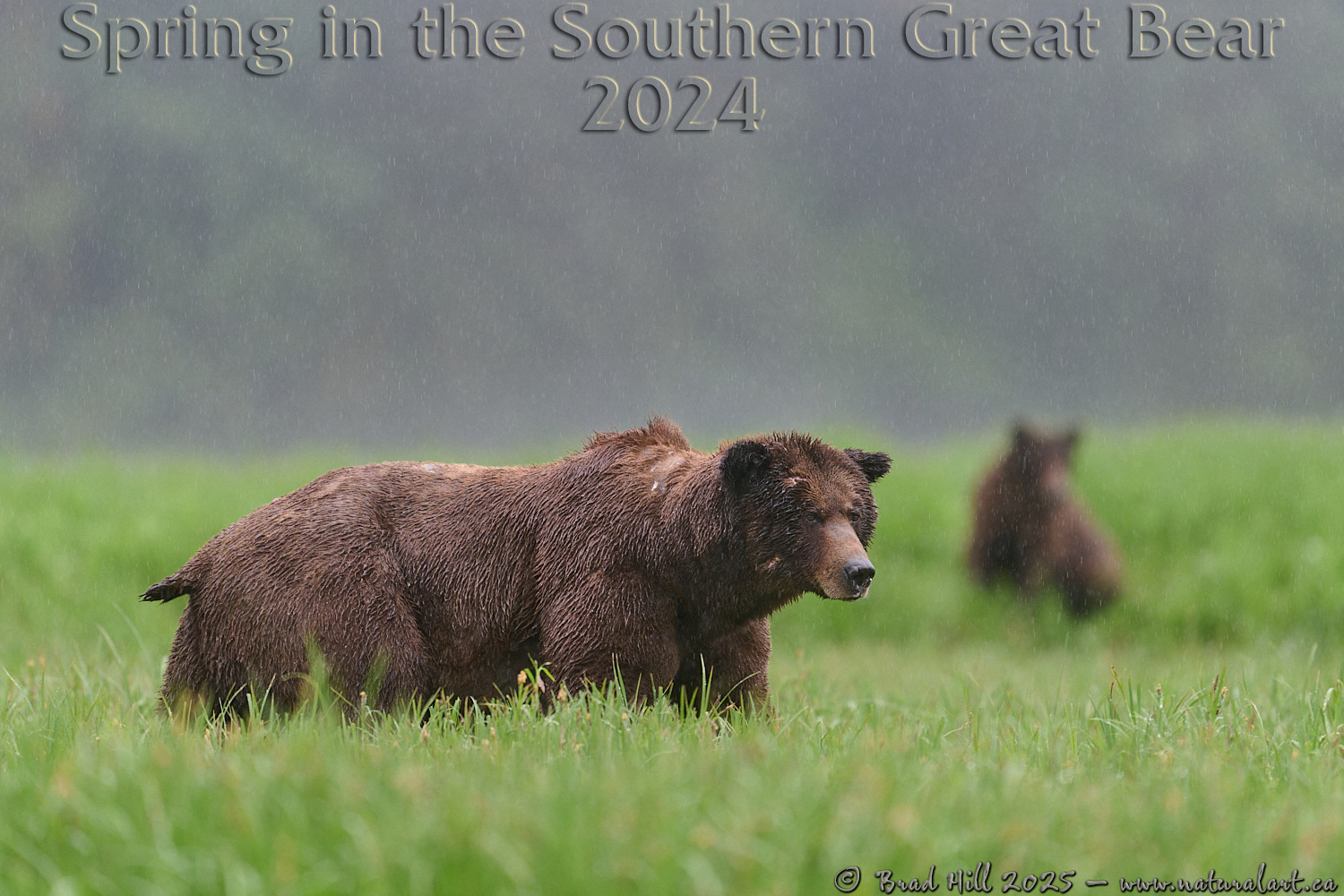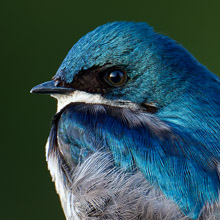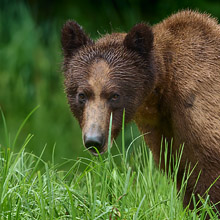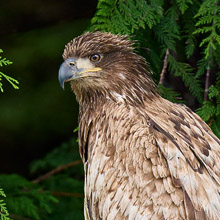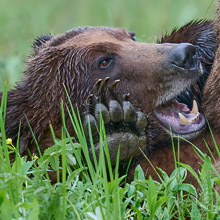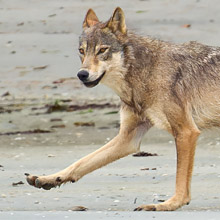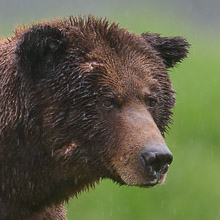Availability: Undetermined - Enquiries?
In the Field
Grizzly Dynamics - Earned Respect. Great Bear Rainforest, British Columbia, Canada. May 31, 2024.
Respect doesn't come easily among male grizzlies in breeding season - it has to be earned. The large and very solid male grizzly featured in this photo bears evidence on his forehead, neck and shoulders of what he went through to achieve "top dog" status in this coastal estuary in the Great Bear Rainforest. When I captured this image the big male grizzly in the foreground was actively guarding and "corralling" an in-heat (or a "just about to come into heat") female. The out-of-focus bear in the background was a second and much smaller male bear who also was accompanied by a female bear. Much to the displeasure of the second male (who was very reluctant to come near the big male, to say the least) the female accompanying him seemed a little fickle, as her interest was focused more on the big guy! Bear dynamics...always fascinating!
Watching and photographing these kind of bear interactions and dynamics is what draws me back to the Great Bear Rainforest each spring. In the spring there are no major salmon runs that draw the region's bears to creeks and rivers. Instead, they are drawn to the estuaries found at the top of inlets to feed on the grass and sedges - and to breed. This breeding activity provides almost countless types of interactions among the bears - chases (between males, between males and females, and even between females), sparring and even serious fights between males, sparring between amorous males and females, males chasing (and sometimes killing) cubs, and more! If you're into seeing bear interactions and real-world bear drama, spring is the time to be in the Great Bear Rainforest.
If you care to join me in the Great Bear to witness the spring bear shenanigans here's some info on what I'll be up to in the next few years...
In 2026 I will be offering ONE spring photo tour into the Great Bear Rainforest - you can view all the gory details (including registration info) here: 8-Day Spring in the Southern Great Bear Instructional Photo Tour
In 2027 I'll be offering TWO spring Grizzlies of the Khutzeymateen photo tours (in the northern portion of the Great Bear Rainforest). While registration for these two photo tours isn't open yet, you can get first right of refusal on the limited number of spots right here: 2027 Priority Booking List.
Here's a larger version (4800 pixel) of this highly respected brute of a bear:
• Grizzly Dynamics - Earned Respect: Download 4800 pixel image (JPEG: 5.0 MB)
ADDITIONAL NOTES:
1. These images - in all resolutions - are protected by copyright. I'm fine with personal uses of them (including use as desktop backgrounds or screensavers on your own computer), but unauthorized commercial use of the image is prohibited by law. Thanks in advance for respecting my copyright!
2. Like all photographs on this website, these images were captured following the strict ethical guidelines described in The Wildlife FIRST! Principles of Photographer Conduct. As such, no baiting or any form of attractant was used and, as always, we attempted to minimize our impact on the ongoing behaviour of the subjects. I strongly encourage all wildlife photographers to always put the welfare of their subjects above the value of their photographs.
3. This image was captured during my Spring in the Southern Great Bear instructional photo tour in late spring of 2024. Each year I offer photo tours into the Great Bear Rainforest and, every other year, photo tours into the Khutzeymateen Grizzly Sanctuary (to photograph grizzlies, of course!). Details about these trips can be found on the Photo Tours page of this website.
Behind the Camera
Grizzly Dynamics - Earned Respect. Great Bear Rainforest, British Columbia, Canada. May 31, 2024.
High Efficiency* Compressed RAW (NEF) format; ISO 2200.
Nikon Z 9 paired with Nikkor Z 400mm f2.8S @ 560mm (built-in TC engaged). Hand-held from a floating Zodiac inflatable boat. VR on in Sport mode. Dynamic-area (M) AF area mode.
1/400s @ f4; No compensation from matrix-metered exposure setting.
At the Computer
Grizzly Dynamics - Earned Respect. Great Bear Rainforest, British Columbia, Canada. May 31, 2024.
Initial noise reduction and capture sharpening on the .nef (raw) file using the DeepPRIME algorithm of DXO PhotoLab 7.7 Elite (using the appropriate lens/camera optical module).
Subsequent adjustments to the adjusted linear DNG file (exported from PhotoLab) and conversion to 16-bit TIFF file (and JPEG files for web use) - including all global and selective adjustments - made using Capture One Pro (build 16.4.3). In the case of this image the global adjustments included just a tweak to the Blacks. Selective local adjustments performed using Capture One Pro's layers and masking tools. In this case numerous small adjustments and minor tweaks were made on 3 separate layers, with the tweaks being associated with "exposure balancing" and contrast adjustments (such as adjustments to brightness, clarity, highlights, shadows, etc.).
Photoshop modifications included insertion of the watermark and/or text.
Conservation
Grizzly Dynamics - Earned Respect. Great Bear Rainforest, British Columbia, Canada. May 31, 2024.
Species Status in Canada*: Special Concern (May 2002).
While Grizzly Bears (Ursus arctos) are not technically listed as "Endangered" in Canada, they have been extirpated from most of their historical range. Grizzly Bears are far more sensitive to intrusion/disturbance in their habitat than are Black Bears and are being increasingly forced into marginal habitat by human encroachment. The Great Bear Rainforest along the central and northern coast of British Columbia is one of the last strongholds of the Grizzly Bear in Canada, and even this population is coming under increasing pressure.
On December 18, 2017 the government of British Columbia banned grizzly hunting across the entire province. This major conservation victory came after decades of tireless work by many dedicated conservationists and ecologists and, most importantly, it reflects the opinion of the vast majority of British Columbians. And, it means that AT LEAST while the current government remains in power grizzlies are finally "safe" in British Columbia.
Now that we've at least temporarily won the battle to save grizzlies in BC, it's time to re-focus our efforts toward protecting ALL of BC's carnivores, including Gray Wolves, Black Bears, Cougars, Wolverines, and more! Simply put, there are no ecological, economic, or ethical arguments supporting the trophy hunting of carnivores.
*as determined by COSEWIC: The Committee on the Status of Endangered Wildlife in Canada













